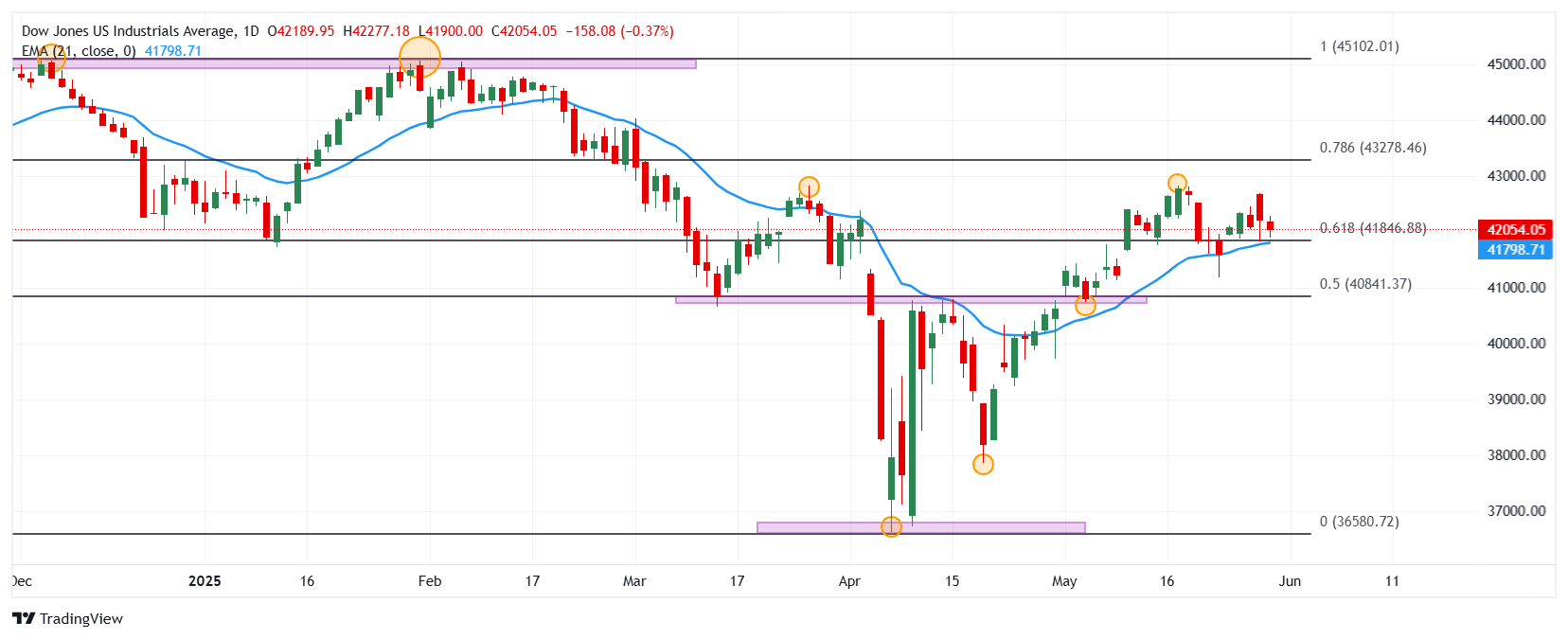- The Dow Jones rises 0.05% daily, currently operating over 4,232.
- The Nasdaq 100 goes back 0.16% today, weighed by regeneon Pharmaceuticals (REGN).
- The S&P 500 falls a $ 0.06 on Friday, falling to a minimum of one week by 5,842.
- The United States Personal Consumer Expenditure Price Index (PCE) is 0.1% in April, in line with market estimates.
- The president of the United States increased commercial nervousness by stating that China has violated the commercial agreement between both nations.
The Dow Jones established a minimum of the day in 41,900, finding buyers who promoted the index to a daily maximum in 42,374.
The Dow Jones industrial average opened 42,189, while the Nasdaq 100 technological index began operating at 21,330. The S&P 500 began negotiations in 5,905, resuming the short -term bass perspective.
Walmart Inc. and Amgen keep Dow Jones in a profit zone
The Dow Jones index wins 0.05% in the day, consolidating within the operating range of May 29 in 42,232.
Wlamart titles (WMT) rebukes 1.67% daily, reaching May 16 at $ 98.93, ending with two consecutive sessions down.
On the other hand, Amgen’s values (AMGN) advance 1.64% in the day, reach maximums not seen since May 2 at $ 288.81, spinning its second consecutive day with profits
The Dow Jones rises 235 points, consolidating within the operational range of the previous session at 42,232.
Regeneron Pharmaceuticals and Marvel Technology lead the falls in Nasdaq 100
The Nasdaq 100 technological index falls 0.16% daily, operating when writing about 21,321.
The Ageneron Pharmaceuticals (REGN) shares collapse 18.90%, reaching minimums not seen since May 6, 2021 in $ 485.00, after failing to a clinical trial.
Following the bearish perspective, the values of Marvell Technology (MRVL) lose 6.86% in the day, visiting May 8 at 58.61 $, signing its second consecutive day down.
In this scenario, Nasdaq 100 slides 34 points, reaching minimum not seen since May 23 at 21,028.
The S&P 500 falls at least one week after the increase in commercial tensions
The president of the United States, Donald Trump, intensified the tariff concerns today, mentioning that China has totally violated his commercial agreement.
The United States Economic Analysis Office announced that the Personal Consumer Expenses Price Index (PCE) was 2.1% in April, slightly improving 2.2 estimated by analysts. At the same time, the Anualized April PCE of April stood at 2.5%, in line with market projections.
The S&P 500 decoced 0.68% on Friday, reaching minimums not seen since May 23 in 5,842, spinning two consecutive sessions with losses. The titles of The Cooper Companies (COO) collapse by 14.02% daily, reaching minimums not seen since November 3, 2022 at $ 65.95.
Technical Analysis of Dow Jones
The Dow Jones established a short -term resistance given by the maximum of May 19 in 42,832. To the south, the first support is located at 40,747, minimum of May 6 in convergence with the 50% fibonacci decline. The following key support is observed in 36,614, pivot point of April 7.
Dow Jones daily graphics

Dow Jones Faqs
The Dow Jones Industrial Avenge, one of the oldest stock market indexes in the world, consists of the 30 most negotiated values in the United States. The index is weighted by the price instead of capitalization. It is calculated by adding the prices of the values that compose it and dividing them by a factor, currently 0.152. The index was founded by Charles Dow, also founder of the Wall Street Journal. In recent years it has been criticized for not being sufficiently representative, since it only follows 30 companies, unlike broader rates such as S&P 500.
There are many factors that promote the Dow Jones Industrial Average (DJIA) index. The main one is the added performance of the companies that compose it, revealed in the quarterly reports of business benefits. The American and world macroeconomic data also contribute, since they influence investor confidence. The level of interest rates, set by the Federal Reserve (FED), also influences the DJia, since it affects the cost of credit, on which many companies depend largely. Therefore, inflation can be a determining factor, as well as other parameters that influence the decisions of the Federal Reserve.
Dow’s theory is a method to identify the main trend of the stock market developed by Charles Dow. A key step is to compare the direction of the Dow Jones Industrial Avenge (DJIA) and the Dow Jones Transportation Average (DJTA) and just follow the trends in which both move in the same direction. The volume is a confirmation criterion. The theory uses elements of maximum and minimum analysis. Dow’s theory raises three phases of the trend: accumulation, when intelligent money begins to buy or sell; Public participation, when the general public joins the trend; and distribution, when intelligent money abandons the trend.
There are several ways to operate with the DJ. One of them is to use ETF that allow investors to negotiate the DJ as a single value, instead of having to buy shares of the 30 companies that compose it. An outstanding example is the SPDR Dow Jones Industrial Avenge ETF (day). Future contracts on the DJ allow the specular operators about the future value of the index and the options provide the right, but not the obligation, to buy or sell the index at a predetermined price in the future. Investment funds allow investors to buy a part of a diversified portfolio of DJ values, which provides exposure to global index.
Source: Fx Street
I am Joshua Winder, a senior-level journalist and editor at World Stock Market. I specialize in covering news related to the stock market and economic trends. With more than 8 years of experience in this field, I have become an expert in financial reporting.





